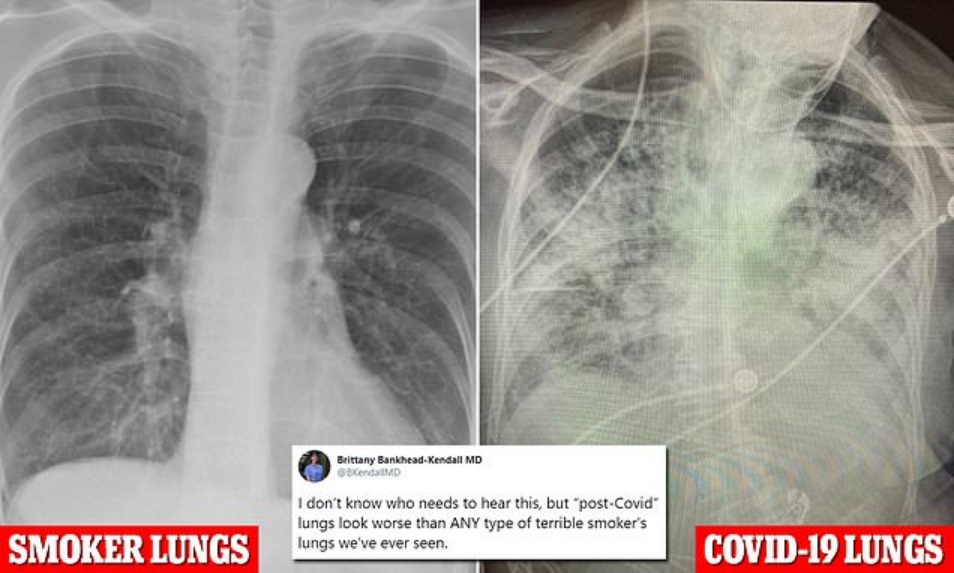A trauma surgeon says lungs of recovered COVID-19 patients look far worse than even those of smokers.
Dr Brittany Bankhead-Kendall, an assistant professor at Texas Tech University Health Sciences Center, has been treating thousand of people ill with the disease since the pandemic exploded in March.
She said X-rays of smokers’ lungs are a bit hazy, but those of coronavirus patients’ lungs are almost completely white – showing intense scarring and a lack of air entering the organs.
‘I don’t know who needs to hear this, but “post-Covid” lungs look worse than ANY type of terrible smoker’s lungs we’ve ever seen,’ Bankhead-Kendall tweeted on January 4.
‘And they collapse. And they clot off. And the shortness of breath lingers on…& on…& on.’
Bankhead-Kendall told CBS DFW that so many health experts have been concentrating on mortality rates and not on the long-term effects of survivors.
‘Everyone’s just so worried about the mortality thing and that’s terrible and it’s awful,’ she said.
‘But man, and all the survivors and the people who have tested positive this is – it’s going to be a problem.’
Coronavirus often leads to complications such as pneumonia, which occurs when the lungs fill with fluid and become inflamed.
As the air sacs fill with fluid, they are unable to take in as much oxygen, which leads to symptoms such as coughing and shortness of breath.
Studies have also found damage to the epithelial cells, which line respiratory passages from the nose to the lungs, of coronavirus patients.
Bankhead-Kendall said that every patient of hers who has exhibited symptoms of the virus has had a severe X-ray.
Among those who are asymptomatic, between 70 to 80 percent have severe results.
‘There are still people who say: “I’m fine I don’t have any issues” and you pull up their chest X-ray and they absolutely have a bad chest X-ray,’ she said.
To show the difference, Bankhead-Kendall shared with CBS DFW three X-rays: one of a healthy patient, one of a smoker and the last of a COVID-19 patient.
The X-ray of the healthy patient shows large amount of black space, which means the person is able to inhale a great deal of air.
Meanwhile, the X-ray of the smoker shows white lines and haziness, indicating inflammation and damage to the walls of the lungs or the air sacs.
COVID LUNGS
Texas doctor @BKendallMD tells me “post-COVID” lungs are worse than any smokers lungs she has ever seen. And it’s a trend she is witnessing in current and recovered patients. Our story tonight on @NewsNationNow.
Scroll: 1) Healthy 2) Smokers 3) COVID pic.twitter.com/Iu9V8OrpnK
— Markie Martin (@MarkieMartin) January 5, 2021
By comparison, the X-ray of the COVID-19 lungs is almost completely white, which are known as lung opacities.
Lung opacities are hazy clouds of white that contrast against the darkness of the lungs, which usually indicates the lungs are full of things such as fluid, bacteria, or immune system cells.
It also means the patient is not able to intake as much oxygen as they normally would be able to with a healthy lung.
‘You’ll either see a lot of that white dense scarring or you’ll see it throughout the entire lung,’ Bankhead-Kendall told CBS DFW.
‘And if you’re not feeling problems now the fact that that’s on your chest X-ray It sure is indicative of you possibly having problems later on.’
Some patients have ended up with permanent lung damage or scarring but it’s not clear if that holds true for all patients.
Public health experts say if that if you still experiencing shortness of breath after recovering from COVID-19, it’s important to contact your primacy care doctor immediately.
